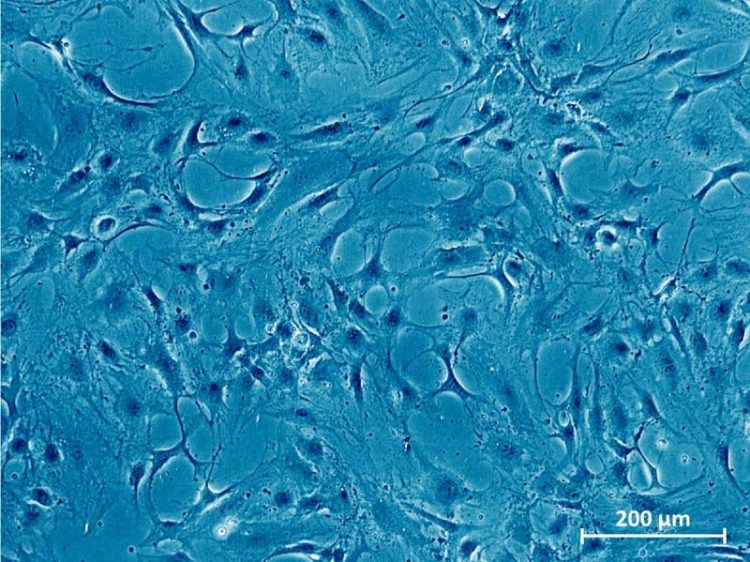Detect cell changes faster

Microscope image of healthy cartilage cells. © Fraunhofer IWS Dresden
The research project focuses on cell monitoring and the early detection of cell changes or damages. This is particularly important when testing the tolerance of new drugs or cosmetics. In conventional tests, cell health is detected by means of biochemical tests, which determine, for example, the metabolic cell activities.
The effect can often only be seen after several days. Transitional states and information on when exactly the first alteration occurs are not yet recorded.
Thus, the efficacy can only be assessed by the final result. In the case, for example, that a drug causes a particular reaction in the cells at an early point in time, it is not possible to detect the reaction at the end of the experiment.
New optical measuring method developed
Here, the collaborative research project comes into play. For the investigation of cell vitality, especially in cartilage and soft tissue, the Leupold-Institute for Applied Natural Sciences of the WHZ together with Fraunhofer AZOM developed a new optical measuring method, which allows an online cell measurement.
The principle relies on a “white light laser”, also known as a supercontinuum source. With intense, ultra-short pulses, it facilitates a non-destructive analysis of cell cultures. The experiments employ primary cells isolated from tissue. These are cultivated in the FILK biological laboratory and placed in different states, e.g. by toxin additions.
The scientists are developing an automated optical measurement procedure for evaluating and recording the material change as well as the size of cell components. Using new data analysis methods, the cell states are now recorded time resolved with high sensitivity. The technology facilitates the analysis of thick, deeper cell structures, an important aspect for investigations on three-dimensional cell cultures and tissues.
Background
In research, cells are studied to identify disease mechanisms. Individual cells or their components are analyzed by means of white laser light and differentiated according to structural features. Changes in human cells can be caused by environmental influences such as toxins or harmful substances, the administration of drugs or the use of cosmetics. Early detection of possible cell damage is particularly beneficial for product tests in the pharmaceutical and cosmetics industries.
About the Application Center for Surface Technologies and Optical Metrology AZOM
The Fraunhofer Institute for Material and Beam Technology IWS operates the Fraunhofer Application Center for Optical Metrology and Surface Technologies (AZOM) in cooperation with the University of Applied Sciences Zwickau (WHZ). The scientists are researching and developing the latest approaches in optical metrology, image processing, process control and surface characterization. They strive to transfer research results quickly and directly into application-specific solutions for industrial processes. AZOM provides an interface between applied science and industry in the fields of medical technology, automotive engineering, mechanical engineering and semiconductor technology.
About the University of Applied Sciences Zwickau (WHZ)
The West Saxon University of Applied Sciences Zwickau concentrates its research on technology, business and quality of life. About 3 800 students from almost 50 countries are enrolled in eight faculties with about 50 courses of study. The WHZ is particularly successful in applied research.
Projects such as the development of a production service data glasses application, the manufacture of capacitive energy storage devices with extremely high charge carrier density or the project to design an automated plug-in system for electromobile local public transport combine 120 years of tradition in engineering education with the requirements of the future.
Head of Fraunhofer AZOM: Prof. Dr. Peter Hartmann
Fraunhofer-Anwendungszentrum für Optische Messtechnik und Oberflächentechnologien AZOM
Keplerstraße 2,08056 Zwickau
peter.hartmann@iws.fraunhofer.de
Phone +49 375 536-1538
https://www.iws.fraunhofer.de/en/pressandmedia/press_releases/2020/presseinforma…
Media Contact
All latest news from the category: Life Sciences and Chemistry
Articles and reports from the Life Sciences and chemistry area deal with applied and basic research into modern biology, chemistry and human medicine.
Valuable information can be found on a range of life sciences fields including bacteriology, biochemistry, bionics, bioinformatics, biophysics, biotechnology, genetics, geobotany, human biology, marine biology, microbiology, molecular biology, cellular biology, zoology, bioinorganic chemistry, microchemistry and environmental chemistry.
Newest articles

Superradiant atoms could push the boundaries of how precisely time can be measured
Superradiant atoms can help us measure time more precisely than ever. In a new study, researchers from the University of Copenhagen present a new method for measuring the time interval,…

Ion thermoelectric conversion devices for near room temperature
The electrode sheet of the thermoelectric device consists of ionic hydrogel, which is sandwiched between the electrodes to form, and the Prussian blue on the electrode undergoes a redox reaction…

Zap Energy achieves 37-million-degree temperatures in a compact device
New publication reports record electron temperatures for a small-scale, sheared-flow-stabilized Z-pinch fusion device. In the nine decades since humans first produced fusion reactions, only a few fusion technologies have demonstrated…





















